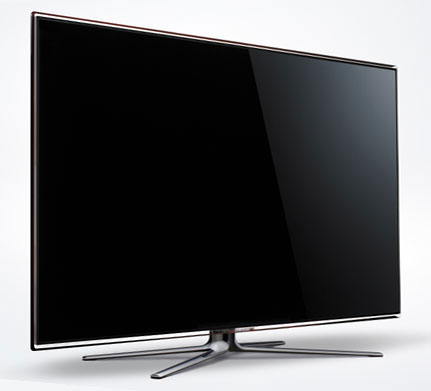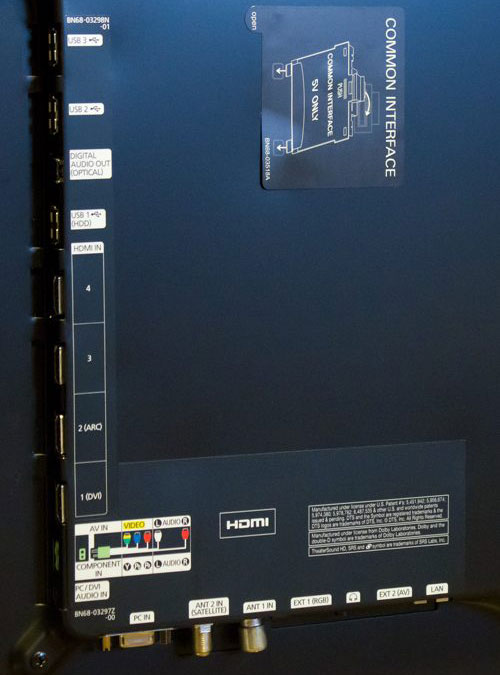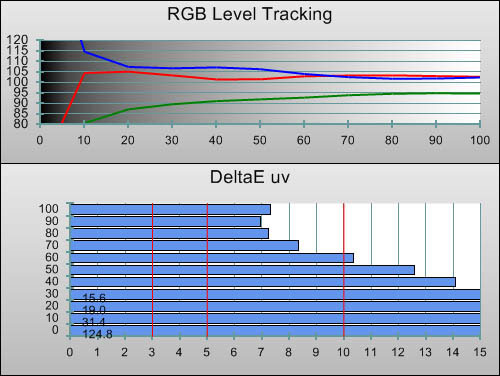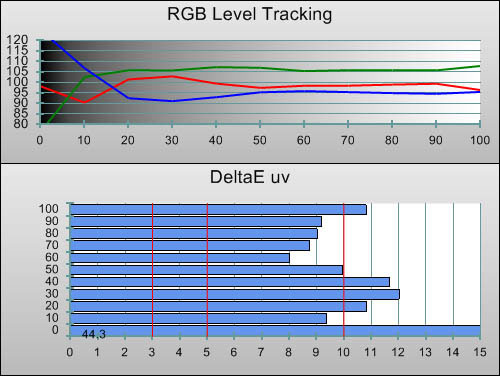Recently, we gave Samsung’s top-end LED LCD TV for 2011, the UE55D8000, a thorough HDTVtest analysis. In for review today though is the UE46D7000, which, according to the Korean manufacturer’s own web site, is identical in technical specification to the D8000 variant. Most online stores sell the D7000 version at around £150-200 less despite the only differences apparently being cosmetic, so the D7000 displays would appear to be the logical choice unless you really crave the D8000’s alternative design – assuming the performance is the same, that is. Let’s see if looks really are the only differentiating factor between the two ranges.
<!-- google_ad_client = 'pub-2887677957235196'; google_ad_slot = '4990177225'; google_ad_width = 336; google_ad_height = 280; //-->
Note: The specific model we reviewed was the Samsung UE46D7000LUXXU, the 3-pin-plug UK version. While we did not review the smaller, 40-inch Samsung UE40D7000, there shouldn’t be any significant difference from the Samsung UE46D7000 in picture performance given similar specifications bar screen size.
Jump To: Operation • Calibration • Picture Performance • Conclusion

The Samsung UE46D7000 is styled very similarly to the D8000 series of LED TV, with a similar “so small it’s barely there” bezel hugging the edges of the LCD panel. Design is highly subjective, but in this reviewer’s opinion, the D7000, with its transparent glass-like acrylic border, seems to look a little nicer than the pricier D8000.
The HDTV sits on top of Samsung’s four-legged “claw” stand, which keeps the ultra-slim display locked in place. Assembly can be a little difficult: since the TV has to be laid face-down for the completed stand assembly to be attached to its back panel, a soft surface (such as a bed or couch) is advised to avoid scratching the screen.
The Samsung UE46D7000 features 4 HDMI inputs, 2 USB sockets, and both Satellite/Freesat and Terrestrial/Freeview tuner inputs. Support for 2 SCART devices and Component video are also offered. The Component video socket also doubles up as a Composite input for lower-quality devices. Like the D8000, a wireless receiver is built in, so no cables are necessary to use the TV’s networking features. There’s also an analogue RGB (PC) input.
 |
| Rear: 4 x HDMI, VGA, component, 2 x Scarts, aerial, Freesat, ethernet & audio outs |
Unsurprisingly, the same redesigned menus we first spotted on the D8000 are present on the Samsung UE46D7000. They match the look of the TV itself, with thin round-edged borders and glass-like transparency effects. The menus are clean and readable, but are a little slow to respond to user input. Samsung HDTVs tend to need a decent amount of user menu adjustment for the best results, so more responsiveness would always be appreciated.
![[Picture] menu](https://www.hdtvtest.co.uk/news/wp-content/uploads/2018/04/hdtv_Samsung-UE46D7000_picture.jpg) |
| [Picture] menu |
![[3D Effect] menu](https://www.hdtvtest.co.uk/news/wp-content/uploads/2018/04/hdtv_Samsung-UE46D7000_3dmenu.jpg) |
| [3D Effect] menu |
The Samsung UE46D7000 has an excellent suite of picture controls, which we’ll use later in the review to calibrate the LED LCD television as closely as possible to industry standards, so we can see images very close to those seen by the filmmakers and other content producers. The less obvious controls include [Shadow Detail], which configures how the LED backlighting should respond when faced with dark programme material; [Gamma], which controls brightness levels inbetween the darkest and brightest points of an image; [White Balance] controls in both 2-point and 10-point varieties (for getting the most neutral and tint-free grey shades); and [LED Motion Plus], which is an LED light “scanning” system which improves the perceived motion clarity in some cases. Tucked away in another menu is control over the [Motion Plus] system, a [Film Mode] deinterlacing control, and two Noise Reduction controls.
The [Digital Noise Filter] is not implemented in the way we’d ideally like it to be, because its “Off” setting doesn’t actually turn it off (we thought this was a bug when we discovered it on Samsung’s televisions last year, but it seems that it’s an intended feature). Although beneficial for noisy video camera material, this also means that detailed film sources have their natural grain texture blurred out, which changes the intended appearance of the film and can create smearing in the image. Enabling “Game Mode” in the 46D7000’s [System] menu is the only way to avoid this, so we’ll also pay close attention to the quality offered by this mode during the review. “Game Mode” uses a different set of picture controls to the standard modes, meaning that we had to calibrate the D7000 twice as a result of our decision to use this mode for movies. We should also point out that enabling “Game Mode” disables the [Motion Plus], [LED Motion Plus] and [10p White Balance] settings, making it a trade-off. For films (which don’t really push the motion limitations of LCD anyway), we felt this was a worthwhile compromise, but one that we don’t think Samsung should be asking any users to make.
Note: Our Samsung UE46D7000 review sample was calibrated using Calman Professional, the industry-leading video calibration software.
Knowing that the UE46D7000 would smooth over fine details in film sources outside of “Game Mode”, we switched into this mode to calibrate the display for Blu-ray movie playback (we’ll calibrate the standard mode later, for completeness, but use “Game Mode” for critical viewing as a result of the undefeatable processing). Once inside “Game Mode”, we changed the default [Colour Tone] to “Warm2” to produce a near-accurate colour of grey (the default setting is blue-tinted). We also verified the [Brightness] and [Contrast] settings using the appropriate test patterns (Contrast had to be lowered a little to avoid whites becoming discoloured). We then performed a 10-step Greyscale measurement run on the D7000 and gathered the following data:
 |
| Pre-calibration RGB tracking and delta errors (dEs) |
In this configuration, the 46D7000 presented the uncanny LED-lit LCD tendency to colour darker shadowed areas with an excess of blue, which seems to be an unavoidable quirk of this screen illumination method (to the eye, the UE46D7000’s blacks do have a slight purple-ish appearance rather than being totally neutral). We then entered the [White Balance] menu and adjusted the low and high end controls by measuring 20% and 80% grey test patterns.
![Post-calibration RGB Tracking in [Game Mode/Standard] mode](https://www.hdtvtest.co.uk/news/wp-content/uploads/2018/04/hdtv_Samsung-UE46D7000_post-rgb.jpg) |
| Post-calibration RGB tracking and dEs in [Game Mode/Standard] mode |
Unsurprisingly, this brought a huge improvement to Greyscale tracking quality, giving us largely neutral greys. Remember that since we’re calibrating the “Game Mode”, we don’t have access to the theoretically perfect quality that would be attainable with the 10-point White Balance menu. We were left with a slight excess of blue in the middle of the range, but we weren’t really troubled by this. Slightly more bothersome was the 10% stimulus area, which was left with a slight blue tint.
![Gamma curve in [Game Mode/Standard] mode](https://www.hdtvtest.co.uk/news/wp-content/uploads/2018/04/hdtv_Samsung-UE46D7000_post-gamma.jpg) | |
| Gamma curve in [Game Mode/Standard] mode | Corresponding gamma tracking |
Samsung TVs have produced excellent Gamma tracking recently, and the UE46D7000 was no exception. There were no obvious peaks and dips, and unlike Plasma panels, no dimming at the highest luminance levels. In other words, the HDTV was consistently outputting the correct amount of light relative to the brightness levels of the input video signal.
As promised, we also calibrated the Samsung UE46D7000 in its standard “Movie” mode, which performs undefeatable noise smoothing, but has the benefits of the [Motion Plus], [LED Motion Plus] and [10p White Balance] adjustments. We were very content to use this mode for content that wasn’t affected by the aforementioned smoothing (in other words, most non-film programmes). Greyscale tracking was essentially perfect in this mode, although we had to sacrifice a very small amount of colour accuracy due to the fact that the [Colour Space] custom settings had to be shared with the “Game Mode” we’d just calibrated (since we use this mode for movies, we gave it priority). Samsung’s colour management menu is excellent, however, and we could have just as easily done things the other way around had we chosen to.
![Post-calibration RGB Tracking in [Game Mode/Standard] mode](https://www.hdtvtest.co.uk/news/wp-content/uploads/2018/04/hdtv_Samsung-UE46D7000_normal-post-rgb.jpg) |
| Post-calibration RGB tracking and dEs in [Movie] mode |
![Gamma curve in [Game Mode/Standard] mode](https://www.hdtvtest.co.uk/news/wp-content/uploads/2018/04/hdtv_Samsung-UE46D7000_normal-post-gamma.jpg) | |
| Gamma curve in [Movie] mode | Corresponding gamma tracking |
There were no surprises here – the out-of-the-box colour performance on the UE46D7000 was already very good indeed (LED-lit displays appear to be “just able” to meet the HDTV Rec.709 colour gamut, so for the manufacturers selling them it’s probably just as well that “Wide colour” LCD displays fell out of fashion a few years ago). We used the [Colour Space] menu to correct any minor accuracies that existed in the out of the box configuration. The result was almost perfect, with only the blue primary colour remaining slightly undersaturated.
![Post-calibration CIE chart in [Game Mode/Standard] mode](https://www.hdtvtest.co.uk/news/wp-content/uploads/2018/04/hdtv_Samsung-UE46D7000_post-cie.jpg) |
| Post-calibration CIE chart with reference to HD Rec.709 |
The [Colour Space] menu also allows for the luminance of the colours to be adjusted (it’s not immediately apparent how to do this, but it’s can be done). This allowed for the following essentially perfect result:
![Post-calibration Luminance levels in [Game Mode/Standard] mode](https://www.hdtvtest.co.uk/news/wp-content/uploads/2018/04/hdtv_Samsung-UE46D7000_post-colour-lum.jpg) |
| Post-calibration colour luminance (coloured bars = targets; black bars = measured values) |
The active-shutter 3D glasses we received in the box with the UE46D7000 were of the SSG-3100GB variety; the lightweight, “battery-style” watch powered glasses we became accustomed to with last year’s Samsung 3D LED LCD televisions. Although they don’t block light from entering the viewer’s eyes from the sides, they are fairly comfortable to wear. We powered these glasses on and placed them in front of our Klein K-10 meter to perform measurements.
 |
| 3D Pre-calibration RGB tracking and delta errors (dEs) |
As we found when we reviewed the D8000 model, the combination of UE46D7000 3D TV and the supplied 3D glasses presented images with a slight green tint. The error is fairly consistent and easy to ignore, far better than the unevenly tinted images put out by Panasonic’s and Samsung’s 2010 Plasmas in 3D.
![3D Post-calibration RGB Tracking in [Game Mode/Standard] mode](https://www.hdtvtest.co.uk/news/wp-content/uploads/2018/04/hdtv_Samsung-UE46D7000_3d-post-rgb.jpg) |
| 3D Post-calibration RGB tracking and dEs in [Game Mode/Standard] mode |
Calibrated image quality was, again, similar to the D8000, although in this instance, the familiar excess of blue in shadowed areas hung around for 3D, too. We’re not sure if this is the result of the individual LCD panel we reviewed, the 3D glasses themselves, or a genuine difference which exists with the D7000 vs the D8000.
Like all Samsung HDTVs, the UE46D7000 has only one set of [Colour Space] adjustments per input, meaning that calibrating the 3D mode’s colour reproduction to near-perfection would have lowered accuracy for 2D signals. Fortunately, the errors, as usual, are small, and given the small amount of 3D content actually available right now, we decided to just leave things as-is, and live with this very small shortcoming.
![3D Post-calibration CIE chart in [Game Mode/Standard] mode](https://www.hdtvtest.co.uk/news/wp-content/uploads/2018/04/hdtv_Samsung-UE46D7000_3d-post-cie.jpg) |
| 3D Post-calibration CIE chart with reference to HD Rec.709 |
| Dead pixels | None |
| Screen uniformity | Visible unevenness, especially at edges |
| Overscanning on HDMI | 0% with [P.SIZE] set to ?Just Scan? |
| Blacker than black | Passed |
| Calibrated black level (black screen) | 0 cd/m2 (LEDs switch off) |
| Calibrated black level (ANSI checkerboard) | 0.044 cd/m2 |
| Black level retention | Stable, subtle rising in “Game Mode” |
| Primary chromaticity | Excellent |
| Scaling | Excellent, smooth |
| Video mode deinterlacing | Very effective jaggies reduction |
| Film mode deinterlacing | Passed 2-2 PAL and 3-2 NTSC tests in SD and HD |
| Viewing angle | Good for LCD; gamma/greyscale shift from sides |
| Motion resolution | 300 in “Game Mode”, 1080 otherwise with [Motion Plus] “Clear” and [LED Motion Plus] On |
| Digital noise reduction | Undefeatable smoothing can cause blur, except in ?Game Mode? |
| Sharpness | Defeatable edge enhancement |
| Luma/Chroma bandwidth (2D Blu-ray) | Full Luma, Chroma horizontally blurred except in “Game Mode” |
| 1080p/24 capability | Some judder present |
| Input lag | 33ms in [Game Mode] and “PC” label |
| Full 4:4:4 reproduction (PC) | Yes, with input mode set to “PC” |
| Default [Standard] mode (2D) | 101 watts |
| Default [Standard] mode (3D) | 111watts |
| Calibrated [Game/Standard] mode (2D) | 72 watts |
| Calibrated [Movie] mode (3D) | 111 watts |
| Standby | 1 watt |
Only last year, Samsung’s LED-sidelit LCD displays had contrast performance which was less impressive than the traditional “bulky” (term used lightly) back-lit LCD displays. This has been much improved for the 2011 models. On the UE55D8000 we reviewed, we measured 0.03 cd/m2 from the black patch in the middle of an ANSI checkerboard test pattern. The UE46D7000 returned 0.044 cd/m2 from the centre square, but 0.033 cd/m2 from the top-right patch, which again seems to be the screen’s non-uniformity rearing its head (the difference wasn’t visible by eye of course, since it’s so small, but perhaps the UE40D7000 may perform better in this regard due to its smaller screen size). This is very good contrast performance.
Being movie lovers, we calibrated the “Game Mode” of the D7000 and used this as our primary mode for Blu-ray, since this bypasses the grain blurring process. In this mode, the Samsung UE46D7000 displayed the standard “non-assisted” LCD figure of 300 lines motion resolution, which is what we expected given that “Game Mode” disables the [Motion Plus] system. This is not really a problem for films, due to their low frame rate (24fps). For high motion video content, we would advise disabling “Game Mode”, which will grant access to the [Motion Plus] and [LED Motion Plus] options, both of which allow all 1080 lines of motion resolution to be displayed more clearly.
In practice, the motion clarity displayed by the UE46D7000, however impressive, still doesn’t beat a Plasma TV. Although Plasma televisions can be prone to contouring during fast motion, the images put out by high-end LCDs still don’t feel quite as “alive”, presumably as a result of the fundamental differences in the ways the two display technologies are driven. Of course, the flip-side also applies: there are some users who feel that Plasma displays flicker too much, who will certainly enjoy the “easy-on-the-eyes” UE46D7000. At the time of writing, the situation could probably be summed up as follows: top-end Plasmas produce perceptibly sharper motion but with some coarseness visible in the image, whereas the very best LCD TV panels produce some motion blurring but little in the way of other unwanted surprises.
3D material can look absolutely excellent on the Samsung UE46D7000. Yes, glowing around high contrast edges (crosstalk) still exists, but it has been curtailed significantly compared to Samsung’s first 3D TVs (where it was obvious and distracting). Samsung have made a remarkable improvement in a very short space of time, and although we should really celebrate what we have in the present, it does make us wonder what 2012 is going to hold.
The D7000’s strengths in 3D mode are numerous. For a start, the LED-lit nature of the panel allows the display to pump out a sufficient amount of light, allowing it to do a good job of compensating for the light loss imposed by the active shutter glasses. Secondly, its 3D images are full resolution. Panasonic’s 3D Plasmas, for all their crosstalk-free strengths, usually do not manage to resolve all of the vertical resolution present in a 1080p 3D HD signal (and LG’s passive 3D LCD televisions come nowhere near): the Samsung UE46D7000’s 3D images are presented with full detail and absolutely no jaggedness. Third, the 3DTV produces suitably accurate Greyscale and Colour reproduction after calibration through the 3D glasses (which sadly is probably not going to be an option for the majority of users; but the pre-calibrated performance in the “Movie” mode wasn’t half bad, either).
So, what’s the downside? There’s still some motion judder present, as we also found with the D8000. When we tested a 24fps 3D Blu-ray Disc, we found that by default, the 3D mode has the [Motion Plus] system enabled. This results in obvious frame interpolation, with all the hyper-smooth motion and processing blips that you’d expect from such a system. After turning this system off, the 3D TV stopped generating “false motion” and just displayed the original film frames without any motion smoothing attempts, but the way in which these are output to the panel has a small rhythmic judder to it. This is especially the case with European-style 50hz sources.
We weren’t expecting any revelations when it comes to SD performance with the UE46D7000, since Samsung are already doing a fantastic job in this area and really don’t have much to improve. Jaggies with interlaced material? Almost none. Film mode deinterlacing? Yep, it’s in there and it works nicely. Scaling? Smooth, natural-looking, and free of unwanted ringing; the company’s usual.
We had a look at the newly released French Blu-ray version of Lost In Translation on the UE46D7000, which, although not an example of the highest clarity Blu-ray has to offer, is an improvement on previous releases. This was a nice test for the Samsung UE46D7000, since it gave us an opportunity to see if raising the TV’s own sharpness control could compensate for the film’s own softness. In this case, the 46D7000’s video processing did a very good job of gently sharpening the image. The accurate greyscale and gamut performance presented a picture free of unwanted tinting or distorted colours. Outside of “Game Mode”, the HDTV’s undefeatable noise reduction smoothed over most of the grain and caused the image to look softer as a result. The sporadic motion resulting from the loose, handheld camera-work also created a little trailing around objects, so we soon switched back into “Game Mode”.
Of course, we also tested the UE46D7000 with a more detailed video transfer (the UK version of Minority Report). Again, in the Game Mode, we were very happy with the image quality thanks to the aforementioned strengths, although in an ideal world we’d be free of the slight motion judder (outside of Game Mode, the judder is lessened, but still exists). In this configuration, the Samsung D7000 presented a richly detailed image with full resolution, and suitably rich contrast.
During flipping between the “Game” and “Movie” modes, we discovered another layer in the “undefeatable noise reduction” saga: there’s a bug whereby the [Digital Noise Filter] setting will change without the user requesting it. If we changed to the internal TV tuner input, and then back to the HDMI1 input that our Blu-ray player was connected to, we noticed that a large amount of noise reduction was being applied to the picture, causing the obvious smearing with grainy film content that we’ve commented on many times before. If we then changed the [Digital Noise Filter] setting from “Off” to “Low” and then back to “Off” again, the smearing was greatly reduced, and only a small amount of NR was being applied, making the forced noise reduction much less obvious. In other words, although the on screen menu reports that the setting is “Off”, what’s going on behind the scenes is quite different. Outside of “Game Mode”, the Samsung UE46D7000 always applies noise reduction to the image, but the intensity of the processing can vary – all while the Digital Noise Filter is reported as being “Off”.
Although it didn’t deliver the fastest and most immersive gaming experience we’ve seen from a flat panel TV, the UE46D7000 did a fairly good job in throwing images onto its LCD panel without much in the way of lag. Games felt fairly responsive and playable (again, provided “Game Mode” was enabled – shucks, what can’t it do!), and we measured lag as being just 33ms, which, unsurprisingly, is the same result as the UE55D8000 we reviewed previously. This level of performance will please most gamers, but for readers who have ultra-twitchy reflexes, there are a few faster HDTVs on the market.
Note: Please refer to our UE55D8000 review for details about the Smart TV interface, as it is the same across both ranges.
Given the near identical specifications of the D7000 and D8000 series of LED LCD TVs, we were expecting near identical performance – and that’s exactly what we found. The Samsung UE46D7000 shares the same strengths and weaknesses as the equivalent UE46D8000 model, but knocks £150-200 off the price, and becomes more appealing in the process. Its biggest remaining issues relate to screen uniformity (the panel isn’t consistently lit across its surface), as well as with (nearly) undefeatable noise smoothing which can produce an unappealing motion blurring effect with grainy film material (it can be side-stepped if the user activates “Game Mode”, but this involves some small picture quality trade-offs). Our last criticism relates to the HDTV’s price: being video enthusiasts first and foremost, we do need to point out that a good amount of the D7000’s still high price tag results from its excellent design, which is of secondary importance to us compared to picture quality. Of course, value is entirely subjective.
Putting those issues aside, it’s mostly good news. The UE46D7000 has a great assortment of picture calibration controls which allow the LCD panel’s output to be adjusted to within an inch of its life, resulting in images that are realistically coloured. Additionally, this 3DTV is capable of some very appealing 3D images: Samsung has seemingly performed miracles and has brought crosstalk artefacting down to “mildly irritating” levels, a huge improvement on first-generation 3D LCD attempts. The D7000 produces a consistently coloured, full resolution image in 3D mode, with little in the way of unwanted artefacts. Crosstalk has always been the biggest weakness of LCD-based 3D TVs, but if it’s being cleaned up at this fast a rate, it seems that LCD will certainly be able to hold its own when it comes to tri-dimensional images.

<!-- google_ad_client = 'pub-2887677957235196'; google_ad_slot = '0693194791'; google_ad_width = 336; google_ad_height = 280; //-->